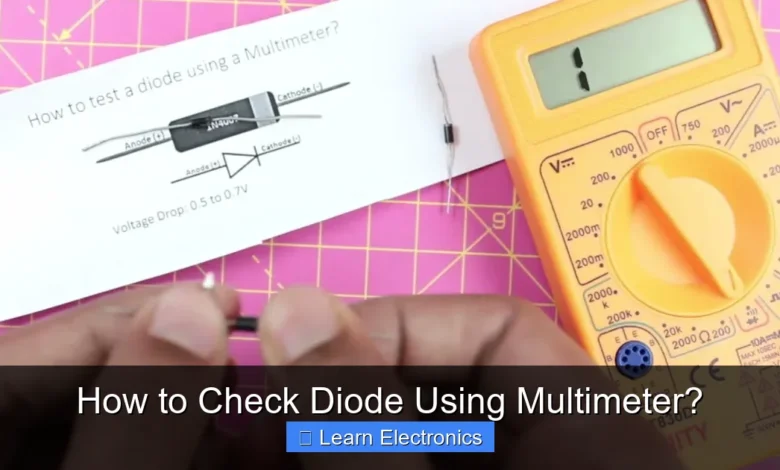How to Check Diode Using Multimeter?

How to Check Diode Using Multimeter? involves setting your multimeter to its diode test function or resistance mode and then observing the readings as you apply forward and reverse bias across the component. This straightforward technique is essential for verifying diode functionality and integrity in various electronic circuits. Mastering this method allows hobbyists and professionals alike to quickly diagnose component issues and ensure proper circuit operation.
Quick Answers to Common Questions
What multimeter setting should I use to check a diode?
To accurately check a diode using a multimeter, select the diode test mode on your digital multimeter, typically indicated by a diode symbol. If you’re using an analog multimeter, the resistance (ohms) setting, usually Rx1 or Rx10, will work best.
What readings should I expect for a good diode?
A healthy diode will show a voltage drop (often between 0.2V and 0.7V) in the forward bias direction when you check diode using multimeter. In the reverse bias direction, a good diode will display “OL” (open loop) or “1” on the screen, indicating no current flow.
What if my multimeter shows “OL” or “1” in both directions?
If your multimeter shows “OL” or “1” in both directions during the diode test, it means the diode is open and faulty, preventing current flow altogether. Conversely, a reading of zero or very low resistance in both directions indicates a shorted diode, which is also bad.
📑 Table of Contents
Understanding Diodes and Their Function
Diodes are fundamental semiconductor devices that permit current to flow predominantly in one direction. They are crucial components in nearly all electronic circuits, serving various purposes such as rectification, voltage regulation, signal mixing, and protection against reverse voltage. A diode consists of a p-n junction, with an anode (positive) and a cathode (negative) terminal.
How a Diode Works
When a voltage is applied across a diode such that the anode is positive relative to the cathode (forward bias), the diode allows current to flow once a certain threshold voltage (known as the forward voltage drop or cut-in voltage, typically 0.7V for silicon and 0.3V for germanium) is exceeded. In contrast, when the cathode is positive relative to the anode (reverse bias), the diode blocks current flow, behaving like an open circuit. Ideally, no current should flow in reverse bias, although a very small leakage current is present.
Why Testing Diodes is Important
Diodes can fail in several ways: they might become an open circuit (no current flows in either direction), a short circuit (current flows freely in both directions), or develop a leakage path in reverse bias. A faulty diode can cause a circuit to malfunction, stop working entirely, or even damage other components. Regular or diagnostic testing using proper methods is key to effective troubleshooting and repair.
Preparing Your Multimeter for Diode Testing
Before you begin the diagnostic process, proper preparation of your tools is crucial. A multimeter is an indispensable instrument for any electronics enthusiast or professional.
Choosing the Right Multimeter
While most modern digital multimeters (DMMs) include a dedicated diode test mode, some older analog multimeters or simpler DMMs might require you to use the resistance (ohms) setting. A DMM with a diode test function is generally preferred as it displays the forward voltage drop directly, which is more informative.
Setting Up for a Diode Check Using Multimeter
First, ensure the circuit containing the diode is completely powered off and any capacitors are discharged to prevent accidental shocks or damage to the multimeter. If possible, desolder one lead of the diode from the circuit to isolate it for more accurate readings, as other components in the circuit can influence the test results. Insert the red test lead into the “VΩmA” or “+” jack and the black test lead into the “COM” or “-” jack on your multimeter.
- For Diode Test Mode: Turn the multimeter’s rotary switch to the diode symbol (often an arrow pointing towards a bar). This mode typically applies a small voltage (around 2-3V) across the diode and measures the voltage drop.
- For Resistance Mode: If your multimeter lacks a diode test function, set it to a resistance range (e.g., 1kΩ or 10kΩ). This method provides a comparative resistance reading for forward and reverse bias.
The Diode Test Mode Method
This is the most common and generally recommended approach for diode testing due to its accuracy and clear interpretation.
Forward Bias Test
With your multimeter in diode test mode:
- Connect the red (positive) test lead to the diode’s anode.
- Connect the black (negative) test lead to the diode’s cathode.
A good silicon diode should display a reading between 0.5V and 0.8V (typically around 0.7V). Germanium diodes will show a lower reading, around 0.2V to 0.3V. LED (Light Emitting Diode) forward voltage drops can vary widely, from 1.5V to 3.5V depending on the color. If you see a reading of ‘OL’ (Over Limit), ‘1’, or a similar indication, it means the diode is open or you’ve connected it incorrectly.
Reverse Bias Test
Now, reverse the multimeter leads:
- Connect the red (positive) test lead to the diode’s cathode.
- Connect the black (negative) test lead to the diode’s anode.
A healthy diode should display ‘OL’, ‘1’, or an equivalent reading indicating an open circuit. This signifies that the diode is effectively blocking current flow in the reverse direction. If you get a low voltage reading (similar to the forward bias reading) or a specific numerical value other than ‘OL’, it indicates the diode is shorted or leaky.
Interpreting the Readings
Proper interpretation of the readings obtained using this method is vital for accurate diagnosis:
- Good Diode: A low voltage reading (0.5V-0.8V for silicon) in forward bias and ‘OL’ in reverse bias.
- Open Diode: ‘OL’ in both forward and reverse bias. The diode is completely non-conductive.
- Shorted Diode: A very low reading or 0V in both forward and reverse bias. The diode is essentially a conductor in both directions.
- Leaky Diode: A numerical reading (not ‘OL’) in reverse bias, often higher than the forward voltage drop but not infinite. This suggests partial breakdown.
Testing Diodes Using Resistance Mode (Alternative Method)
If your multimeter does not feature a dedicated diode test mode, the resistance mode can be used as an alternative, though it provides less precise information about the forward voltage drop.
Conducting the Resistance Test
Set your multimeter to a medium resistance range (e.g., 1kΩ or 10kΩ). The specific resistance range may influence the readings, so consistency is key.
- Forward Bias: Connect the red lead to the anode and the black lead to the cathode. Note the resistance reading.
- Reverse Bias: Connect the red lead to the cathode and the black lead to the anode. Note the resistance reading again.
Analyzing Resistance Values
In resistance mode, a good diode will exhibit a significantly different resistance reading in forward bias compared to reverse bias.
- Forward Bias: You should measure a relatively low resistance (hundreds of ohms to a few kilohms), indicating current flow.
- Reverse Bias: You should measure a very high resistance or ‘OL’ (infinite resistance), indicating that the diode is blocking current effectively.
A diode is likely faulty if you measure:
- Low resistance in both directions (shorted).
- High or infinite resistance in both directions (open).
- Similar resistance readings in both directions (leaky or faulty).
Be aware that the actual resistance values can vary depending on the multimeter’s internal battery voltage and the specific resistance range selected. The key is the significant difference between forward and reverse readings.
Common Diode Failures and Troubleshooting
Understanding the common failure modes helps in pinpointing the problem quickly during troubleshooting.
Open Diodes
An open diode acts like a broken wire, preventing current flow in both directions. In diode test mode, it will show ‘OL’ (Over Limit) in both forward and reverse bias. In resistance mode, it will show very high or infinite resistance in both directions. This failure can be caused by excessive current, heat, or physical damage.
Shorted Diodes
A shorted diode behaves like a regular wire, allowing current to pass freely in both directions. In diode test mode, it will display a very low voltage reading (often close to 0V) in both forward and reverse bias. In resistance mode, it will show very low resistance in both directions. This usually occurs due to an over-voltage condition or prolonged overheating, causing the p-n junction to break down permanently.
Leaky Diodes
A leaky diode is a partial failure where the diode doesn’t block current perfectly in reverse bias. While it may still conduct in forward bias, it will allow some undesirable current to flow in the reverse direction. In diode test mode, you might get a numerical reading (not ‘OL’) during reverse bias, although typically higher than the forward voltage drop. In resistance mode, you’d observe a measurable, albeit high, resistance in reverse bias instead of ‘OL’. This degradation can occur over time due to stress or minor damage to the junction.
Data Table: Multimeter Readings for Diode States
This table summarizes the expected readings for a standard silicon diode (like 1N4007) when tested with a digital multimeter in diode test mode.
| Diode State | Forward Bias (Red on Anode, Black on Cathode) | Reverse Bias (Red on Cathode, Black on Anode) |
|---|---|---|
| Good Diode | 0.5V – 0.8V (e.g., 0.7V) | “OL” (Over Limit / Open Circuit) |
| Open Diode | “OL” | “OL” |
| Shorted Diode | ~0V or very low reading | ~0V or very low reading |
| Leaky Diode | 0.5V – 0.8V | Numerical reading (e.g., 1.5V) or lower ‘OL’ than good diode |
Safety Precautions and Best Practices
Working with electronics always requires adherence to safety guidelines to protect yourself and your equipment.
- Always Power Off: Before testing any component in a circuit, ensure the power is completely disconnected and all high-voltage capacitors are discharged. Live testing can damage your multimeter and pose a shock hazard.
- Isolate Components: For the most accurate readings, desolder at least one lead of the diode from the circuit. This prevents parallel paths through other components from skewing your measurements.
- Read Your Multimeter Manual: Familiarize yourself with your specific multimeter’s features, ranges, and safety warnings. Not all multimeters behave identically.
- Check Multimeter Batteries: A low battery in your multimeter can lead to inaccurate readings, especially in resistance mode.
- Use Proper Leads: Ensure your test leads are in good condition, without any frayed wires or damaged insulation.
- Proper Handling: Avoid touching the metal tips of the test leads simultaneously when testing, especially when dealing with potentially charged components.
Mastering the technique for checking a diode using a multimeter is a foundational skill for anyone involved in electronics. By understanding the principles of diode operation and applying the described multimeter tests, you can reliably identify faulty components and maintain the health of your electronic devices and projects. This method provides clear indications of a diode’s health, making troubleshooting more efficient and accurate.
Frequently Asked Questions
How do I check a diode using a multimeter in its most basic form?
To check a diode, set your multimeter to the diode test mode. Connect the red probe to the anode and the black probe to the cathode (forward bias) and note the voltage drop reading. Then, reverse the probes (reverse bias); a good diode should show an “OL” or “1” indicating an open circuit.
What are the expected readings for a good diode when tested with a multimeter?
In forward bias, a good silicon diode will typically show a voltage drop between 0.5V and 0.8V, while a germanium diode will show around 0.2V to 0.3V. In reverse bias, the multimeter should display “OL” (Over Limit) or “1,” indicating very high resistance and no current flow.
How can I tell if a diode is bad or faulty when checking it using a multimeter?
A bad diode will show abnormal readings. If it reads “OL” or “1” in both forward and reverse bias, it’s open-circuited. If it shows a low resistance or a similar voltage drop in both directions, it’s likely short-circuited.
Which specific setting on my multimeter should I use to check a diode?
You should primarily use the dedicated diode test mode, usually indicated by a diode symbol (a triangle with a line). This mode applies a small voltage to the diode and displays the forward voltage drop directly. While you can use resistance mode, the diode test mode provides a more accurate and informative measurement of its functionality.
Why is it important to test a diode in both directions when checking it using a multimeter?
Diodes are unidirectional devices, meaning they allow current to flow primarily in one direction (forward bias) and block it in the other (reverse bias). Testing in both directions confirms this critical characteristic, distinguishing a functional diode from a short circuit or an open circuit.



